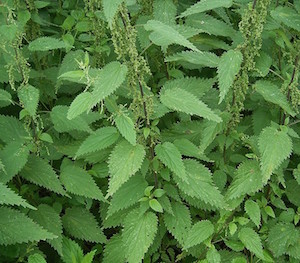The benefits of nettles are something every person suffering with kidney problems (and everyone who wishes to prevent them) should know.
What are Stinging Nettles?
 As far back as medieval times, the stinging nettle (Urtica dioica) has been in use as a natural diuretic to flush excess fluids from the body.
As far back as medieval times, the stinging nettle (Urtica dioica) has been in use as a natural diuretic to flush excess fluids from the body.
The stinging nettle is a perennial (lives a long time) flowering plant that is one of the first to appear after the cold of winter recedes. The agricultural community considers them a weed so you shouldn’t have a problem getting permission to harvest any that you find.
They are a found in the wild on almost every continent and are easy to identify. They grow in clusters and return to the same areas every year. Shady areas with rich soil are their preferred habitat. Often clustered along fences, near water sources, or along trails, it is critical that you exercise caution before collecting them.
You must always wear gloves when handling them! The dark green leaves are covered with fine spines that resemble hair. These emit histamines when touched. Leaves are shaped like a heart, rough to the touch, a few inches in length, and end with a pointed tip. Early in the season, they’ll grow low to the ground but by the time cold weather descends, they can stand 4-6 feet tall.
Benefits of Nettles for Your Kidneys
Nettles are amazing little things for a whole host of different ailments. They are a natural, effective treatment for pain relief (used for arthritis, muscle aches, and insect bites), inflammation (highly effective in the treatment of gout and skin conditions), to improve immunity, anemia, hay fever, and to lower blood sugar or blood pressure.
However, the renal system seems to gain the greatest benefits of nettles!
As a natural detoxifier, blood purifier, and diuretic, nettles work to remove impurities such as bacteria, calcium crystal deposits, grit and kidney stones from your kidneys, bladder, and urinary tract. This helps to prevent formation of kidney stones and the discomfort of urinary tract infections (UTI). The removal of excess water in the extremities (hands, feet, and face) is a particular benefit to kidney patients who may be unable to accomplish this task automatically.
It may also have a positive effect on your bowels.
How to Use Stinging Nettles
There are products on the market that you can buy without harvesting the plant yourself. Manufacturers use the majority of the plant (leaf, roots, and stems) in various products such as extracts, dried leaves, tinctures, juices, pills, or tea. There are even ointments that are applied directly to the skin for joint pain relief.
Due to the abundance of this plant in the wild, if you can harvest it yourself, I highly suggest it! Gloves are a must and you must be sure not to touch any part of the plant to your bare skin. It will feel similar to a sting for a couple of hours. Simply hold the stem with one gloved hand while you clip away leaves with the other into a container. Don’t pull it up by the roots or take all the stems and leaves. Taking only what you need will ensure that it will grow back.
Once the leaves are collected, processing (such as steaming) removes the danger of histamines and breaks down the spines. The texture is similar to that of turnip greens with a delicate flavor. Dishes that call for kale, greens, or spinach can be substituted with stinging nettle. They are particularly delicious tossed with a bit of olive oil and garlic!
Stinging Nettle Tea
Ingredients
- 1 cup rinsed stinging nettle leaves (rinsed)
- 2 cups water
- Honey or other natural sugar to taste (optional)
Directions
- Rinse leaves while you bring water to a boil.
- Toss leaves in and boil for 1 minute.
- Reduce heat and simmer for 2 minutes.
- Strain out the leaves, separating the liquid only into a cup.
- Sweeten with honey or maple sugar to taste if needed.
If you live in a developed area or aren’t the “nature type,” get the dried leaves and make a renal detoxifying tea at home! Follow the directions on the packages since you likely won’t need as many of the dry variety.
A Word of Caution about Stinging Nettle
As with any “new” food to your system, try a small amount and determine if you personally tolerate it well. Rare side effects are stomach upset. If you tolerate the tea well, it is safe to drink two cups per day.
Pregnant women should never take a product or consume a tea that contains stinging nettle as it could induce early labor or miscarriage. Just like any use of diuretic, you must drink more fluids than usual to avoid dehydration. Since it lowers blood pressure, be cognizant of a drop that exceeds what you can handle.
The benefits of stinging nettles are waiting for you – likely just outside your door!
If you want to find out more about protecting your kidneys (so you can keep them all your life), then take a look at my book “The Water of Life – Be Sure to Take Care of Your Kidneys.” I give you the scoop on how to prevent kidney deterioration, how to guard against inflammation, and show you natural ways to boost kidney health right now!
